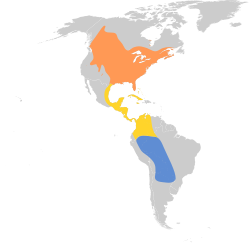| Eastern kingbird | |
|---|---|
 | |
| Adult | |
| Scientific classification | |
| Kingdom: | Animalia |
| Phylum: | Chordata |
| Class: | Aves |
| Order: | Passeriformes |
| Family: | Tyrannidae |
| Genus: | Tyrannus |
| Species: | T. tyrannus |
| Binomial name | |
| Tyrannus tyrannus | |
 | |
| T. tyrannus range Breeding range Wintering range Migration | |
| Synonyms | |
Lanius tyrannusLinnaeus, 1758 | |

The eastern kingbird (Tyrannus tyrannus) is a large tyrant flycatcher native to the Americas. The bird is predominantly dark gray with white underbelly and pointed wings. [2] Eastern kingbirds are conspicuous and are commonly found in open areas with scattered trees and bushes, where they perch while foraging for insects. [3] The Eastern kingbird is migratory, with its breeding range spread across North America and its wintering range in Central and South America. [1]



